Note: This article was the MASS Research Review cover story for January 2024 and is part of their “From the Mailbag” series of articles. If you want more content like this, subscribe to MASS.
This article isn’t about the exact question listed above. In reality, it’s about an entire genre of questions that involve trying to reach a specific body-fat percentage within a specific (and often very short) time frame. I’ve answered this question countless times throughout my fitness career, and the person who asks the question is virtually never satisfied by my response. The truth is, I am generally critical of this question because I’m critical of the goal-setting process it reflects. I never set a specific body-fat percentage as the goal of a diet or program, and I prefer to utilize flexible timelines rather than a specific deadline for goal completion (whenever possible). In this article, I’ll explain why body-fat goals with fixed timelines are inadvisable and offer a better alternative.
Nobody Cares What Your Body-Fat Percentage Is
My first issue with making a specific body-fat percentage your goal is related to logical reasoning rather than empirical scientific data. Simply put, nobody cares what your body-fat percentage is (including you, most likely). In my experience, body-fat goals are (at best) proxies that are believed to be roughly compatible with the true goal. For example, someone might want to get down to 20% body-fat because their most recent blood tests revealed high cholesterol and impaired glycemic control. They might assume that they can get those blood biomarkers in check if they’re able to get down to 20% body-fat, which may indeed be true. However, their goal isn’t actually the body-fat percentage; if they got to 20% body-fat and still had high cholesterol and impaired glycemic control, they wouldn’t have achieved the actual endpoints they were truly hoping for.
Sometimes people will set body-fat goals because they believe it will improve their athletic performance. For example, a powerlifter might believe they’d be more competitive in a lower weight class, or an athlete might believe they’d be more explosive if they had a more favorable strength-to-mass or power-to-mass ratio. These folks might assume that their athletic goals would be taken care of if they reached their intended body-fat level, but body-fat percentage is once again a poor proxy in this scenario. If a powerlifter got down to their goal body-fat percentage, competed in a lower weight class, but ended up performing poorly and placing worse, I doubt they’d be satisfied with that set of outcomes.
Sometimes people will set body-fat goals because they believe it will help them achieve a particular aesthetic appearance. For example, someone might see a fitness model or bodybuilding competitor with a desirable physique, estimate that individual’s body-fat percentage, then set out to attain that very same body-fat percentage. The most common approaches for visually estimating someone’s body-fat percentage are either guessing or using a three-by-three grid of images with estimated body-fat ranges. Here’s the problem: body fat distribution varies from person to person, and the visual impact of muscular definition depends on the combined effects of subcutaneous fat storage and underlying muscular development. So, imagine you estimated the body-fat percentage of a fitness model and used that as your goal. Would you be satisfied if you achieved that body-fat percentage but looked totally different due to insufficient muscularity? Alternatively, would you be satisfied if you achieved that body-fat percentage but ended up with absolutely shredded limbs while retaining considerable fat in your abdominal section? The satisfaction that comes from achieving goals is highly subjective, but in most cases, these hypothetical scenarios will lead to more disappointment than satisfaction. Even in competitive bodybuilding, where fixation on body-fat percentage values is rampant among competitors, emphasis on specific body-fat values is misplaced. The leanest bodybuilder doesn’t always win, and judges will never ask, measure, or know your body-fat percentage. The goal of a competitive bodybuilder is to achieve a certain look that balances muscularity, symmetry, and leanness – it’s hard to win a show with high body-fat, but competitors are better served by focusing on their overall physique and presentation instead of focusing exclusively on an arbitrary body-fat percentage goal.
So, if your goal is to improve a health-related metric, set a goal for that health-related metric. If your goal is to improve performance, set a performance goal. If your goal is to look a certain way, set an appearance-oriented goal. In all three scenarios, body-fat percentage is merely a proxy for the true underlying goal, and a poor proxy at that.
Nobody Knows What Your Body-Fat Percentage Is
Let’s assume you skimmed the last section, rejected the premise entirely, and set a goal to achieve a specific body-fat percentage. How would you actually know if you reached your goal?
The most obvious answer is that you’d get your body-fat percentage measured. In reality, this is a surprisingly inadequate answer. Body-fat measurement is categorically off the table; the only way to truly measure body fat is cadaver dissection, and that seems like a pretty extreme choice to me. Instead, there are many common methods for estimating body-fat percentage. The classic estimation methods are underwater weighing and skinfold measurements using calipers. More modern estimation methods include bioelectrical impedance analysis, air displacement plethysmography (BodPod), three-dimensional optical scanners, ultrasound imaging, and dual-energy x-ray absorptiometry (DXA). Intuitively, most people seem pretty comfortable assuming that underwater weighing and skinfold measurements are imperfect methods subject to meaningful estimation error. People tend to naturally assume that older methods are less accurate (if they weren’t, why would we bother to create newer methods?), and it seems pretty far-fetched to assume that identifying the thickness of skinfolds at a few specific sites or identifying your bodyweight in a pool will yield an extremely precise body-fat value. On the other hand, people tend to naturally assume that newer methods are very accurate, especially if they involve equipment that is expensive and technologically impressive. So, do newer estimation methods like BodPod, DXA, and bioelectrical impedance analysis give us precise estimates?
Unfortunately they do not. For example, a cross-sectional study published in 2004 estimated the body-fat percentage of 27 male bodybuilders (1). They used a variety of estimation methods including underwater weighing, deuterium dilution, dual-energy x-ray absorptiometry, prediction equations based on body mass index, skinfold measurement, bioelectrical impedance, a three-compartment model incorporating total body water, and a three-compartment model incorporating bone mineral content. These methods were compared to a four-compartment model, which served as the “gold standard” for comparison purposes. The results of these estimation methods are presented in Figure 1.
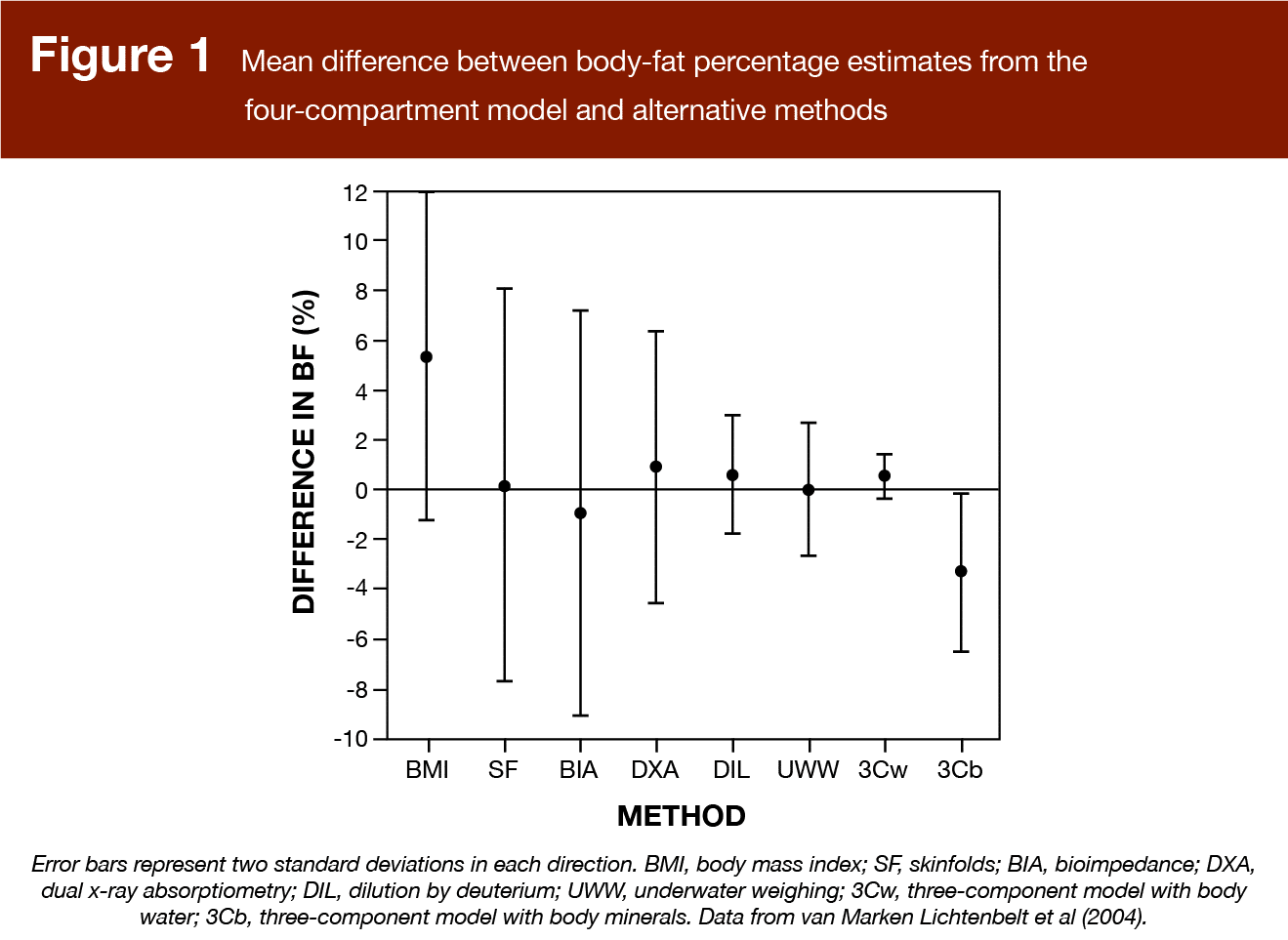
Looking at the wide error bars in Figure 1, you can see that it isn’t particularly rare for common body-fat estimations to overestimate or underestimate body-fat by several points. For example, the error bars for DXA span from roughly +6 to -5. Imagine your goal was to cut from 15% body-fat to 10% body-fat – a fairly typical fluctuation for someone transitioning from the end of a winter bulk to a manageable cut for the summer months. It’s not totally implausible to imagine a scenario where DXA underestimates your body-fat by 5 points at the start of the cut, and overestimates your body-fat by 5 points at the end of the cut. You could fully achieve the goal, while your body-fat estimates would reflect no change in body-fat percentage (despite a substantial drop in body mass). In other words, you did exactly what you set out to do, but DXA would suggest that you were shedding lean mass at an alarming rate. Of course, the opposite could also occur – if DXA overestimated your body-fat by 5 points at the start of the cut and underestimated your body-fat by 5 points at the end of the cut, you’d be convinced that your cut was dramatically more successful than it truly was. To be fair, Figure 1 isn’t all bad news for body composition estimation. If you look at the average value for each estimation method, they performed pretty well at the group level. They overestimated some people, underestimated some people, but overall provided a pretty good estimate of the group-level average. This figure demonstrates why these body composition estimation techniques are fantastic for assessing group-level averages in research, but inadequate for precise estimates at the individual level.
The data presented in Figure 1 might be convincing to some, but I’m sure there are people wondering about two specific details: how might these data look for non-bodybuilders, and what do the individual data points actually look like? To address both considerations, Figure 2 displays some data that I presented back in 2017 (2). We estimated body-fat percentage values in 34 adults with overweight or obesity using BodPod, DXA, and ultrasound, and compared these values to a gold standard four-compartment estimate. Figure 2 shows three different Bland-Altman plots, which each visualize the level of agreement between two of the measurement devices. For example, the first plot in Figure 2 is labeled “DXA.” The x-axis values are the “average” body-fat estimate obtained from DXA and the measure it’s being compared to (the “gold standard” four-compartment model). In other words, you estimate body-fat via DXA, estimate body-fat via the four-compartment model, and take the average of the two to obtain the x-value. The y-value is the difference between the two estimation methods. The larger the difference, the lower the level of agreement between the two measurement techniques. The thin bold line in each figure represents the average difference, and the dashed lines represent the 95% limits of agreement. The 95% limits of agreement are roughly two standard deviations above and below the mean difference, and should generally contain about 95% of the difference values for 95 percent of future measurement pairs.
Looking at Figure 2, we see that the group-level average estimates were pretty good, but individual-level estimates revealed considerable error. While BodPod performed surprisingly well, some DXA values underestimated body-fat by up to 5 percentage points or overestimated body-fat by up to 10 percentage points. For someone who is adamant to determine if they’re 10% body-fat or 12% body-fat, that’s not particularly helpful. If a body-fat estimation method is merely going to get you within a plausible range (plus or minus a few percentage points), you can probably guess what that range is before you even get tested.
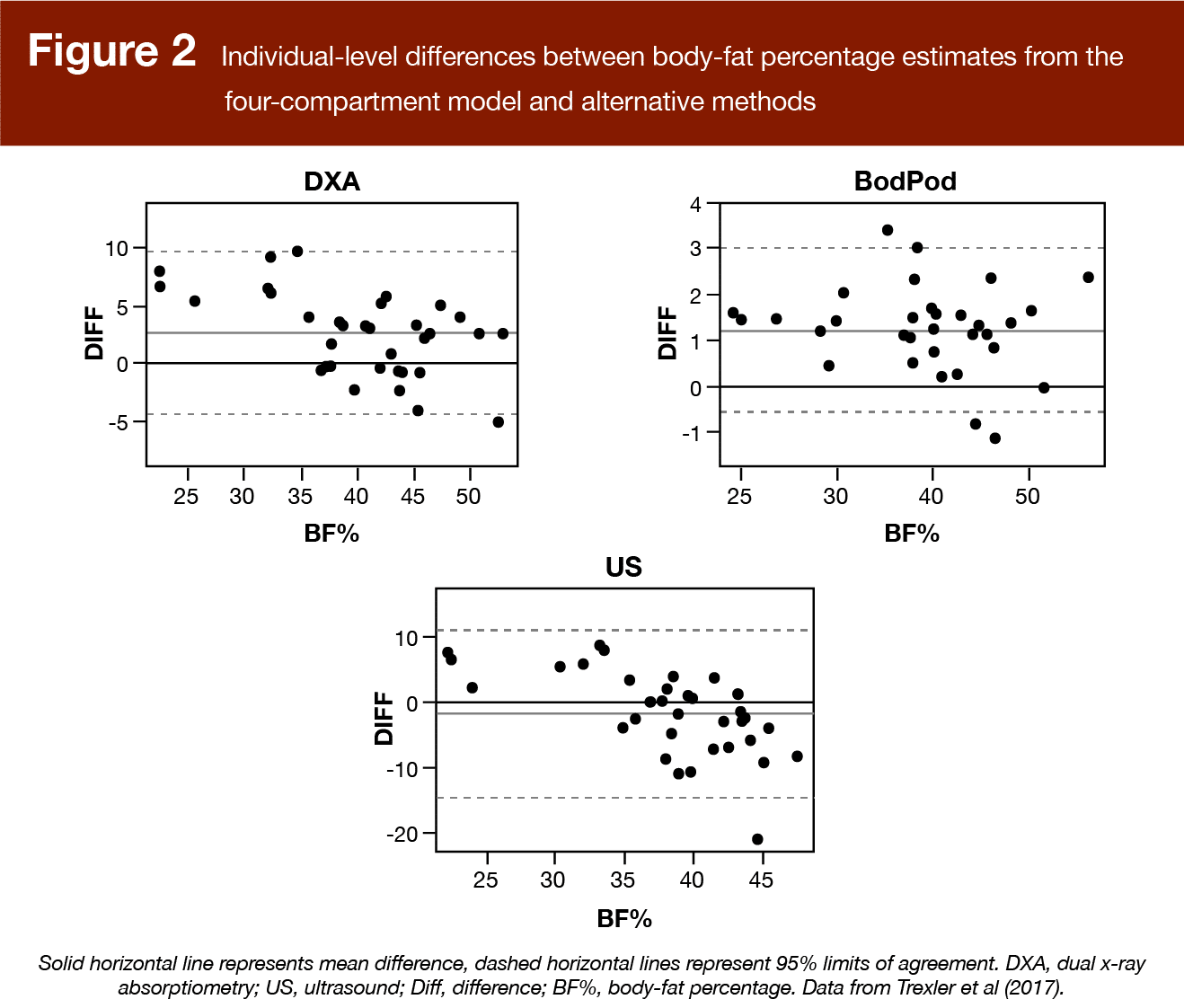
Whenever these limitations of body-fat estimation are discussed, a natural follow-up question comes to mind: baseline body-fat estimates may be a bit off-base, but can’t we use these methods and devices to track body-fat changes over time? When tracking group-level averages, common body-fat estimation methods tend to do quite well. However, the magnitude of error remains a bit too large to lean heavily on these methods for longitudinal tracking of individual-level body-fat changes. In the previously mentioned study by van Marken Lichtenbelt et al, 15 of the 29 bodybuilders participated in a longitudinal intervention where changes in body composition were assessed over time. The group-level differences among estimation methods are presented in Figure 3. In our previously mentioned study, we have 15 pairs of pre-test and post-test values following periods of substantial (≥4.5kg) weight loss. The individual-level differences among estimation methods are presented in Figure 4. In these figures we see wide error bars, wide limits of agreement, and considerable individual-level error when comparing various estimation methods to the four-compartment model.
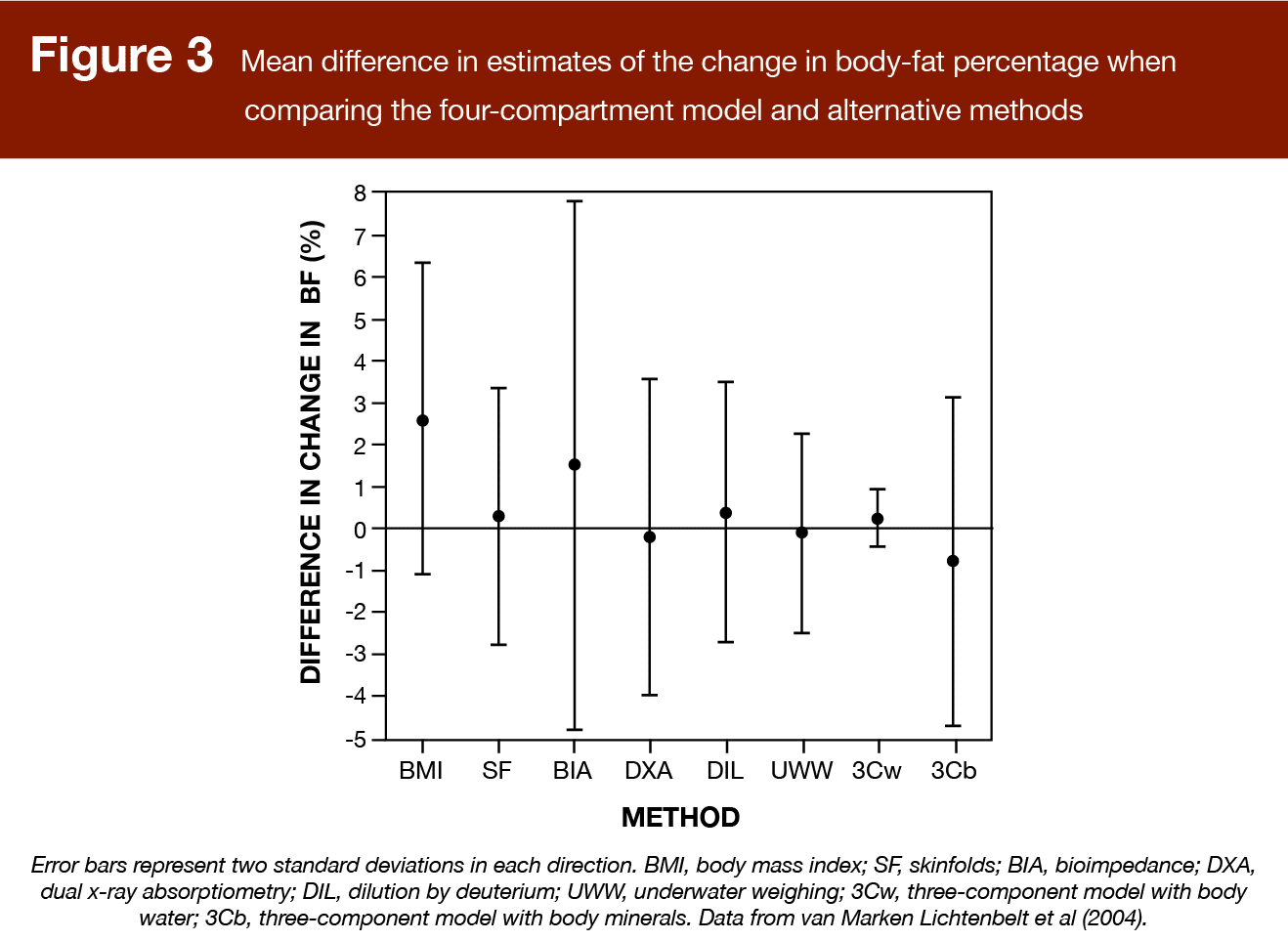
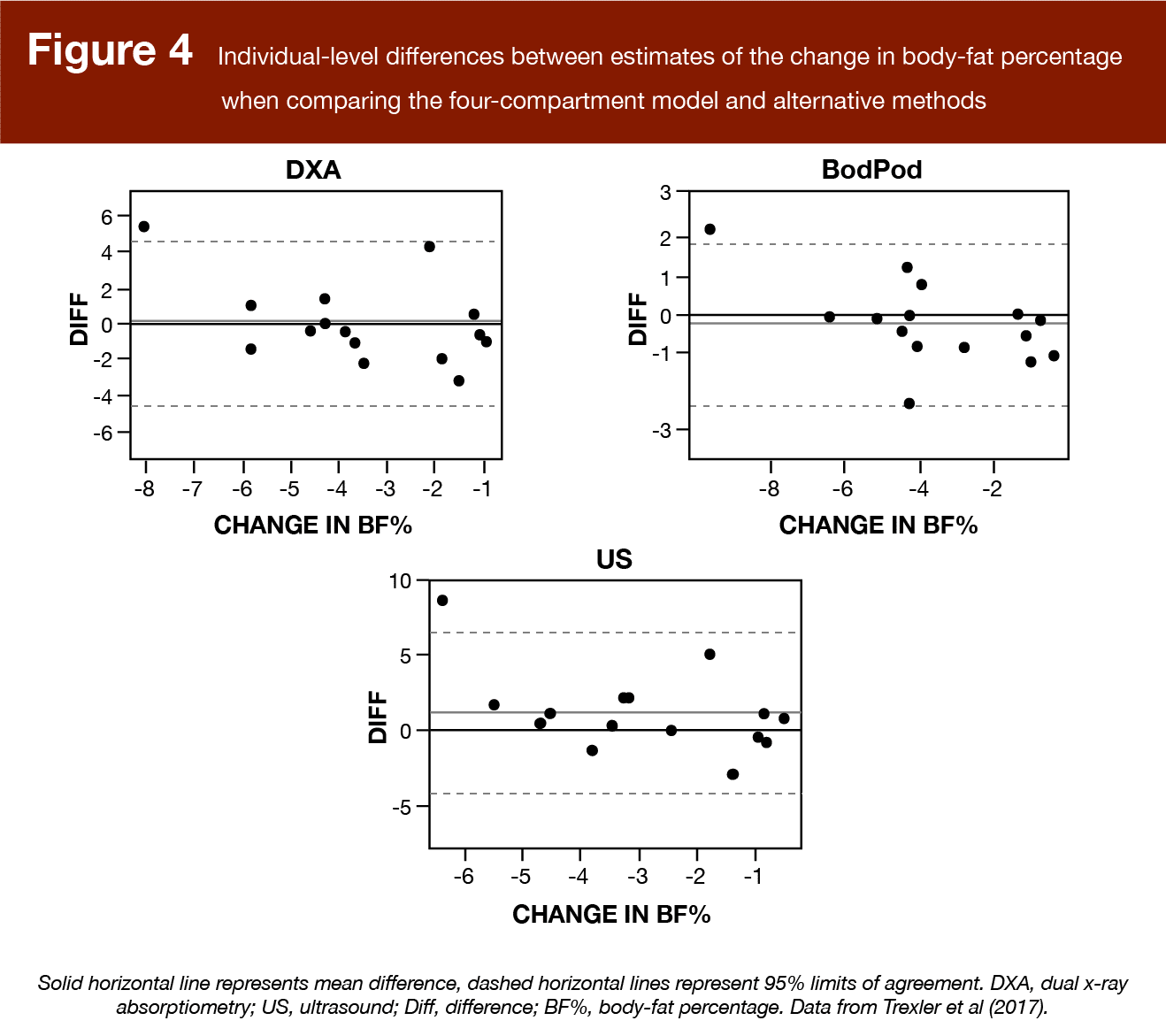
So, even if you truly do care about your body-fat percentage and have access to research-grade estimation methods, you won’t actually know where you started, where you ended, or how much body-fat you lost along the way. From my perspective, setting a goal with a very specific quantitative endpoint that can’t be confidently confirmed or verified is hard to justify.
It’s Difficult to Predict Changes in Fat-Free Mass
Let’s ignore the technicalities of measurement for a while and focus on a practical problem. One of the more common questions I get on Instagram goes something like this: “I’m currently 15% body-fat and I want to cut down to 10% body-fat. How much weight will I need to lose to get there, and how long will that take?”
Even with a perfectly accurate estimate of your baseline body-fat percentage (which we never have), I have no satisfying answer to this question. Broadly speaking, your likelihood of losing, maintaining, or even gaining lean mass during a cut could be dependent upon your training status, your genetic predisposition to muscularity, your non-lifting physical activity habits, the effectiveness of your training program, and dietary factors including protein intake and caloric intake. We have enough information to set general expectations for changes in lean mass during weight loss. For example, beginners are far more likely to gain muscle while losing weight. We also have enough information to guide best practices with regards to maintaining (or gaining) lean mass during weight loss. For example, you definitely don’t want to skimp on protein (3), and you don’t want to implement a massive caloric deficit (4). As shown in Figure 5, large deficits are far more likely to drive the loss of lean mass in comparison to more modest caloric deficits (4). You’d also want to avoid extremely high volumes and frequencies of cardio; while the interference effect is often overstated with regards to hypertrophy or muscle retention, extremely high doses of cardio can certainly interfere with the accretion or retention of lean mass (5).
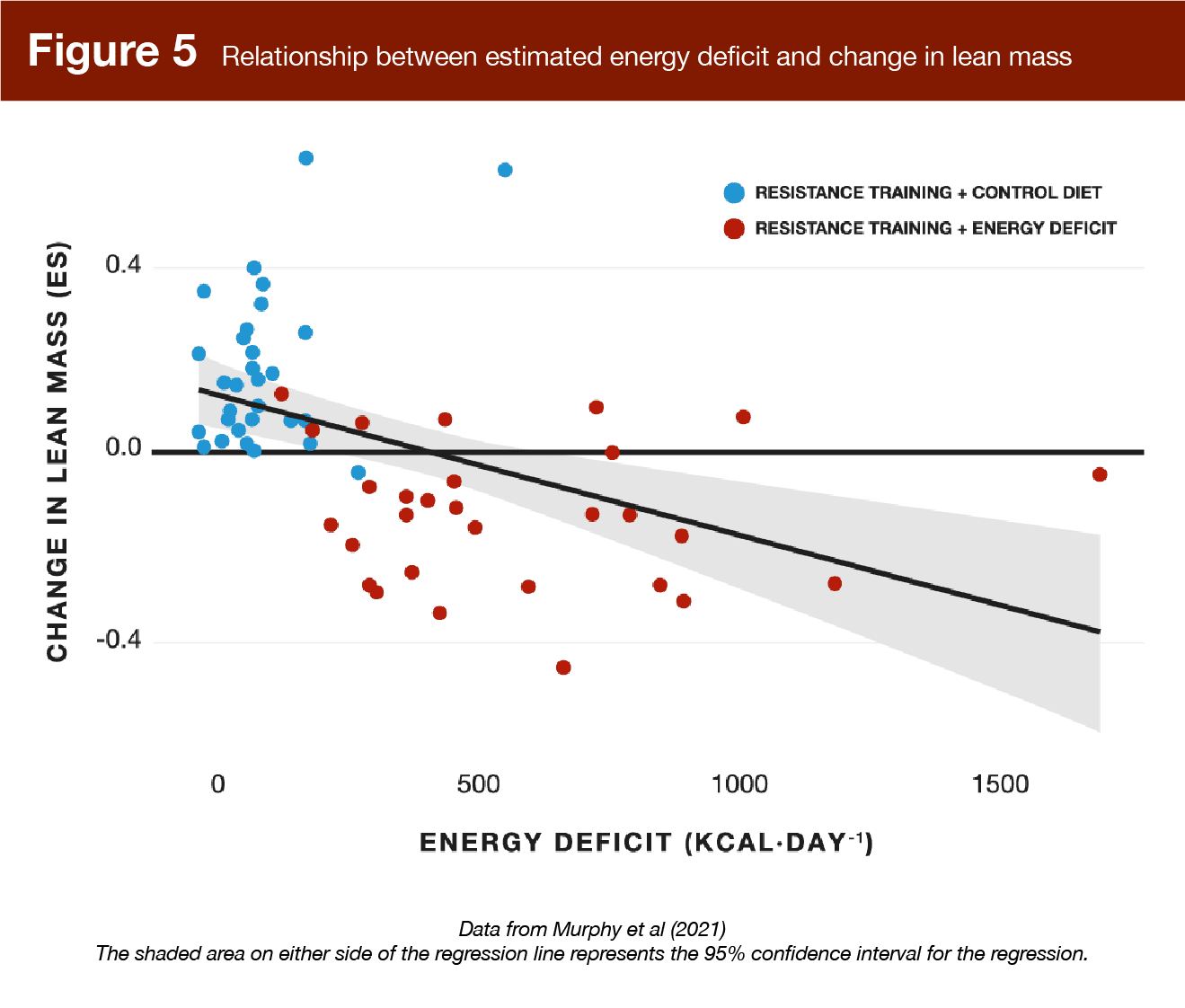
If we want to take a more granular approach to forecasting changes in lean mass, we should probably evaluate training status and specific training variables on a muscle-by-muscle basis. For example, it’s quite common for lifters to focus exclusively on upper-body muscularity early in their lifting career before eventually getting serious about lower-body training. There are plenty of well-trained lifters with exceptional upper-body development who are primed to make “beginner gains” when they start allocating equal attention to their lower-body musculature. Along similar lines, injuries are almost inevitable if you stick with lifting for long enough, whether those injuries occur in the gym or elsewhere. Almost every lifter will experience periods of detraining in response to injuries, and they’re likely to experience rapid gains when they’re able to resume normal training for the affected muscle group(s). When it comes to training status, we often like to broadly categorize people as being a beginner, intermediate, or advanced. However, this overly simplistic approach fails to account for the fact that your various muscle groups may have varying degrees of hypertrophy potential over the next several weeks due to the structure of your future training program and the training program you’ve been following for the last few months.
You can only assess the suitability of a goal to reach a specific body-fat percentage by a deadline if you can accurately predict how lean mass will change during the goal-striving process. That prediction can be very difficult to make with a high level of accuracy, as longitudinal lean mass changes for each individual muscle group will be dictated by a wide range of factors and genetic predisposition will vary from person to person. For very ambitious weight loss goals, it’s also likely that the fraction of weight lost as lean mass will vary over time (generally increasing as you get leaner). The amount of lean mass you gain or lose will impact the amount of weight you need to lose in order to reach your target body-fat percentage, and the amount of weight you need to lose will impact the timeline of your fat loss plan. If you want to know how long it will (or should) take to reach a specific body-fat percentage, I need to predict exactly how much lean mass you might gain or lose during the process. If I’ve been coaching you for a while, I’ll have a pretty good idea; if you’re just DMing me on instagram out of the blue, I can’t make that prediction with high confidence. I’d need to ask you a very long list of questions, make several semi-informed assumptions, then make an uninformed guess about your genetic predisposition for muscle growth and retention.
Fixed Deadlines May Encourage Unsustainable Methods, Rigid Cognitive Restraint, and Excessive Focus on Outcomes Over Processes
By setting a time-capped goal to attain a particular body-fat percentage by a given deadline, you’ve created a mission with two possible outcomes: pass or fail. You either reach the target body-fat percentage by the deadline or you don’t. This type of goal can feed into rigid cognitive restraint, which has been discussed many times before in MASS content (one, two). Rigid restraint is characterized by setting inflexible rules and boundaries, and someone employing rigid cognitive restraint will typically evaluate their progress in dichotomous terms (success or failure, with no gray area). For goals pertaining to dieting and fat loss, rigid dietary restraint is associated with a wide range of negative outcomes, including disordered eating behaviors and attitudes, body image concerns, psychological distress, and poorer well-being (6). Rigid restraint is contrasted by flexible cognitive restraint, which involves a much more flexible approach to striving toward goals and assessing one’s progress. Rather than getting upset about failing to reach a specific body-fat percentage by a given date, someone implementing flexible cognitive restraint would instead acknowledge the partial success they experienced by getting close to their goal and shift their sights toward continuing their trajectory of successful goal striving. Unsurprisingly, flexible cognitive restraint during goal striving is associated with better psychological outcomes, overall well-being, and long-term goal attainment when compared to rigid restraint (6).
Now, let’s say your goal was to reach 10% body-fat in the next eight weeks. Over that eight week period, you estimated that you’d need to lose 12 pounds of fat. It’s now been four weeks, and you’ve only lost 3 pounds of fat. What do you do now?
According to your goal, you should push way harder – you’re not on pace to hit your target body-fat percentage by the deadline, so you need to crank into a higher gear. That doesn’t make very much sense in my opinion. Your goal was to lose 6 pounds in the first four weeks, but despite your best efforts, you fell 3 pounds short. It’s hard to justify the quest to lose 9 pounds in the next four weeks, given the fact that you were unable to lose even 6 pounds in the previous four weeks. Time-capped goals suggest that you should paradoxically make your goal harder when you’re struggling the most, which doesn’t make sense – you are least equipped to increase your target rate of weight loss when you’re already falling short of it. This may lead to unsustainable crash-dieting tactics that involve extreme short-term sacrifices to reach the predetermined body-fat goal “on time,” which doesn’t bode well for long-term success and well-being.
This highlights yet another problem with setting body-fat percentage goals with fixed deadlines. They are, by definition, outcome-oriented (rather than process-oriented). Outcome-oriented goals have a time and a place, but they do have some noteworthy shortcomings. For example, outcome-oriented goals may tend to reinforce rigid restraint (i.e., you either achieve the outcome or you don’t), and may encourage unsustainable “sprints to the finish line” instead of sustainable goal-striving behaviors. In addition, research suggests that people pursuing outcome-oriented goals typically have lower success rates and lower subjective well-being during the goal-striving process (7). Process-oriented goals are particularly helpful for overcoming procrastination; they shift focus toward small steps you can take to support your success right now and away from the (potentially large) gap between your current status and your desired outcome.
I’ve now stated the entirety of my case, so hopefully I’ve talked you out of setting a goal that involves hitting a specific body-fat percentage by a specific date. But what should you do instead?
A Better Alternative for Settings Goals
If you’ve read any of my previous work related to goal setting, I might sound like a broken record here. Nonetheless, I’ll reiterate my stance that goals are best set within the context of a well-aligned goal hierarchy. You can find a more detailed explanation of goal hierarchies here, but the basic idea is to construct an interconnected network of superordinate, intermediate, and subordinate goals. Superordinate goals relate to key values and priorities that reflect your vision of your “best self,” intermediate goals provide some more concrete direction that bring you closer to your best self, and subordinate goals detail the specific actions you’ll take to achieve your intermediate goals (8). An example of a goal hierarchy is presented in Figure 6.
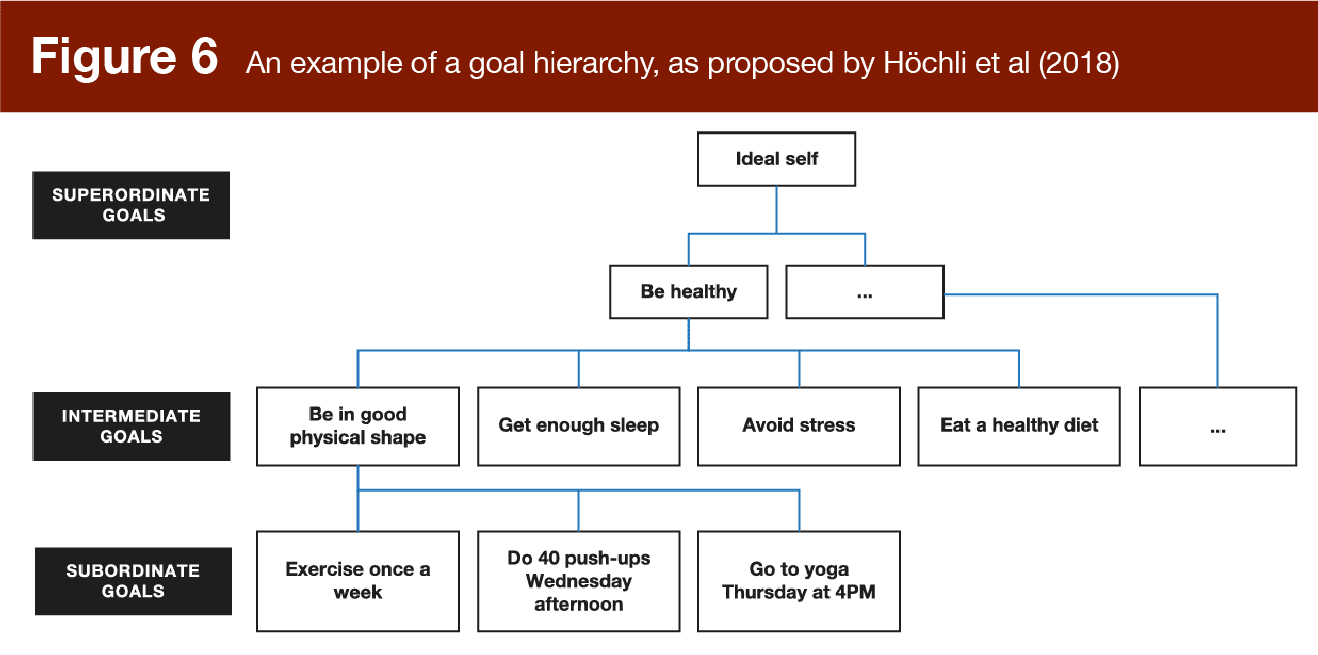
When someone tells me they want to hit a certain body-fat percentage by a given date, my first reaction is to ask them why. Not a superficial explanation of their goal, but a deeper description of why they value fitness and why their fitness goals are so important to them. This usually leads them to a superordinate goal that anchors their goal hierarchy. Next, we need an intermediate goal. As I noted near the beginning of this article, a body-fat percentage is almost never the “real” goal. In most cases, body-fat percentage is standing in as a proxy for a more specific performance goal, physique goal, or health goal. When formulating this into an intermediate goal, I prefer to make it process-oriented whenever possible. For someone with a physique-focused goal, a process-oriented goal might be to lose roughly one pound per week until achieving their desired level of muscular definition. Notably, this intermediate goal describes the path and the process (i.e., establishing and maintaining a deficit that facilitates one pound of weight loss per week) rather than the cumulative outcome of implementing the process for a given amount of time (i.e., losing a specific amount of total weight or fat). Finally, you’ll want to construct a series of subordinate goals to support your intermediate goal. This is where you apply the countless strategies discussed in previous MASS articles – specific strategies pertaining to resistance training, cardio, non-exercise physical activity, energy intake, protein intake, meal timing, and so on. In other words, you map out the strategies that are going to help you create the caloric deficit needed to lose about a pound per week.
If you had set a goal to reach a specific body-fat percentage by a certain date, you’d run into a number of challenges. First, your goal is most likely a proxy for something else that is more meaningful to you. Second, you won’t truly know your starting body-fat percentage, nor will you be able to confidently confirm that you actually reached your intended body-fat percentage in the end. Third, it will be difficult to determine how much weight you should lose along the way, as it will be immensely difficult to predict how much lean mass you will gain or lose along the way. Fourth, if you start falling short of your planned pace of weight loss, you’ll have to start losing weight faster than your original place to make up for lost time. Fifth, you’ll probably have a pretty bad time, which is often the case for outcome-oriented goals that are approached with rigid cognitive restraint. Instead, I hope you’ll consider the alternative – a process-oriented goal with a flexible timeline that is anchored by a well-aligned goal hierarchy that adds meaning to your pursuit.
Get more articles like this
This article was the cover story for the January 2024 issue of MASS Research Review. If you’d like to read the full, 92-page January issue (and dive into the MASS archives), you can subscribe to MASS here.
Subscribers get a new edition of MASS each month. Each issue includes research review articles, video presentations, and audio summaries. PDF issues are usually around 100 pages long.
References
- van Marken Lichtenbelt WD, Hartgens F, Vollaard NBJ, Ebbing S, Kuipers H. Body composition changes in bodybuilders: a method comparison. Med Sci Sports Exerc. 2004 Mar;36(3):490–7.
- Trexler ET, Hirsch KR, Blue MNM, Mock MG, Smith-Ryan AE. Estimating body composition at baseline and tracking changes during weight loss: Validity of common methods in comparison to a criterion four-compartment model. J Int Soc Sports Nutr. 2017 Sep 12;14(2):31.
- Helms ER, Zinn C, Rowlands DS, Brown SR. A systematic review of dietary protein during caloric restriction in resistance trained lean athletes: a case for higher intakes. Int J Sport Nutr Exerc Metab. 2014 Apr;24(2):127–38.
- Murphy C, Koehler K. Energy deficiency impairs resistance training gains in lean mass but not strength: A meta-analysis and meta-regression. Scand J Med Sci Sports. 2022 Jan;32(1):125–37.
- Hickson RC. Interference of strength development by simultaneously training for strength and endurance. Eur J Appl Physiol. 1980;45(2–3):255–63.
- Helms ER, Prnjak K, Linardon J. Towards a Sustainable Nutrition Paradigm in Physique Sport: A Narrative Review. Sports. 2019 Jul 16;7(7):172.
- Kaftan OJ, Freund AM. The Way is the Goal: The Role of Goal Focus for Successful Goal Pursuit and Subjective Well-Being. In: Diener, E; Oishi, S; Tay, L. Handbook of Well-Being. Salt Lake City, UT: DEF Publishers.
- Höchli B, Brügger A, Messner C. How Focusing on Superordinate Goals Motivates Broad, Long-Term Goal Pursuit: A Theoretical Perspective. Front Psychol. 2018;9:1879.




